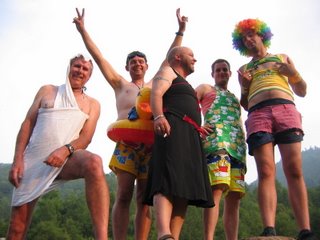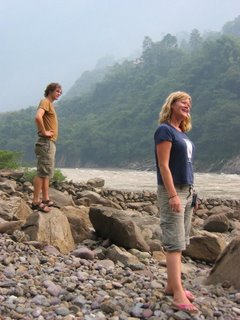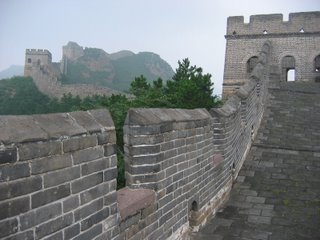The two day high-level trek through Tiger leaping Gorge was brought to my attention by Michael Palin on his Himalaya tour. Since seeing that I have wanted to do this trek. It was with some surprise, therefore, that when push came to shove I found I just couldn't be bothered. This was pretty much the first event of this trip that I have missed out on and in some ways I regret it. The thought of following two nights rough camping with a 2 day trek, potentially in the rain, with another three nights of rough camp close on its heals simply sapped the motivation out of me. So rather than risk spending 2 days wet and miserable I decided to spend the time chilling out in Lijiang.
Lijiang is probably the nicest town we visited in China. The old city, which was built up the side of a small but steep hill, has been sympathetically remodeled into a tourist attraction. The maze like stepped streets of pagoda buildings house a huge range of art and craft stalls and restaurants. The whole effect is magically complemented by hundreds of red paper lanterns hung along the streets and lighting the small stream that flows through the town and under a number of decorative bridges. Exploring the markets, enjoying the restaurants and spending a very pleasant day in the dragon pool park was more than enough compensation missing the trek. Besides I squeezed in a day-trip to the gorge anyway, so what the hell.
Also, as ashamed as I am of doing so in China, the
Frosty Morning Bar and Restaurant (the 'English' bar) do a cracking burger, cold beer (a rarity in China) and Phil, the proprietor, plays a mean game of pool (his wife is meaner still). Check it out if you are ever in Lijiang.
The gorge day-trip was a very commercial affair, designed as it primarily was to provide local market traders with a captive audience. It involved a large amount of time sitting on a bus and listening to Chinese commentary. The guide spoke perfect English but was apparently not in the mood to do so, despite having a greater than 50% European audience. The tour started with a stop at a big and very unmemorable stone tablet, the significance of which I forget, and a traditional music display by some locals. The latter was very impressive if only for the fact that they managed to get something vaguely musical out of the most obscure collection of tin-pot instruments I have ever seen together in one room. The trip then took in the 'first bend' of the Yangtze river, which, whilst being wholely impressive from the air, was wholely the opposite from the ground. This excursion did however provide enterprising local highwaymen with another golden opportunity to fleece gullible tourists. A half-hour boat-journey was on offer and cost around 100 yuan, one of your arms, half a leg, several teeth and at least one camel. We declined.
And so to the final attraction: Tiger Leaping Gorge. In a slightly uncharacteristic show of apathy I had at the time failed to read up on the mythology of this place, and am sorry to say that I have been remiss in following up. I therefore have no idea why the gorge holds this name, other than that at some point an apparently hyper-caffeinated tiger is supposed to have jumped it. Mythology aside, the gorge is a stunningly impressive land-form and the path that has been carved into its side, thus allowing you to traverse the length of the otherwise impassable torrent that flows down it, is an equally impressive feat of engineering. A two hour walk along this path, through some incredible scenery delivers you to 'the rock'. This is allegedly located at the point the tiger jumped and provided a convenient half-way stepping stone for the leap. This no doubt saved the poor creature from downing at least five more Red-Bulls before making the attempt.
Sarcasm aside, the gorge walk rescued an otherwise mediocre day and, combined with a very decent lunch (the ingredience of which I remain mercifully ignorant), made this well worth the money spent. An excellent day had by all.


 Photo courtesy of Ken.
Photo courtesy of Ken.





























